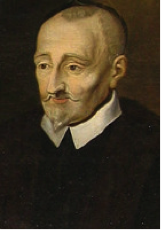 Pierre de Ronsard was a French poet of the 16th century who enjoyed the privileged position throughout most of his adult life of being a favoured poet of the Kings of France. He was generally accepted as the leading writer amongst a group of Renaissance poets called La Pléiade, a collection of talented poets of the time that included Joachim du Bellay and Jean-Antoine de Baif. The members of this group tended to write in a fanciful, graceful style exhibiting the language to its best effect, introducing vivid imagery where possible and endeavouring to use a graceful variety of meter at all times.
Pierre de Ronsard was a French poet of the 16th century who enjoyed the privileged position throughout most of his adult life of being a favoured poet of the Kings of France. He was generally accepted as the leading writer amongst a group of Renaissance poets called La Pléiade, a collection of talented poets of the time that included Joachim du Bellay and Jean-Antoine de Baif. The members of this group tended to write in a fanciful, graceful style exhibiting the language to its best effect, introducing vivid imagery where possible and endeavouring to use a graceful variety of meter at all times.
Ronsard was born in September 1524 at Le Manoir de la Possonnière which was in a village called Couture-sur-Loir. His parents were of noble blood and he spent his early years being educated at home but was sent to Paris at nine years old to study at the College de Navarre. He was selected to act as a page at the wedding of James V of Scotland and Madeleine of France and this was the start of a period of much travel for the young man taking in Scotland, England, Flandres and Holland before he finally returned to France.
He was employed in a number of diplomatic posts including acting as Secretary to Lazare de Baif who was the father of Jean-Antoine, one of his fellow members of La Pléiade. He was also attached to Cardinal du Bellay-Langey’s staff for a time. All of this diplomatic activity contributed to his general education and, of course, enhanced his standing in royal circles. He was becoming a hugely popular poet and was growing prosperous as a result.
He maintained his status as favoured royal poet despite more than one change of sovereign and King Charles IX looked after him very well. As well as allowing Ronsard to take rooms at the royal palace, he granted him other properties and honours including abbacies and priories. A man in such a position was bound to attract enemies of course, and the Huguenots disliked him intensely. They tried their best to discredit him as a libertine at every opportunity and put forward their own poet as a worthy rival to de Ronsard. This was a man called Du Bartas. Written and verbal attacks though were only a part of their campaign against him. They even tried to have him assassinated which was, in truth, fairly typical behaviour of that time.
An example of Ronsard’s lyrical style of poetry is translated below and is called Sur La Mort de Marie. It is possible that it is dedicated to the mistress of the Duke of Anjou. Marie de Clèves died in 1574:

Ronsard was prolific in his writing, often by royal command. King Charles commissioned a work called the Franciade in 1572 but this was not one of his best, by any means. A significant feature of this publication was that it coincided with a particularly bloody period in the French Religious Wars that were going on at the time. The St Bartholomew Massacre took place just before it and featured the persecution and violent deaths of thousands of Huguenot supporters at the hands of the Catholics. Not surprisingly the “royalist” Ronsard’s efforts were looked down upon by the survivors of this massacre.
During the last decade of his life Ronsard moved away from court life as his health declined. He spent his last days mostly at one of his houses in the Vendôme and sometimes with a friend in Paris (Jean Galland). He continued to write almost to the end and it is said that some of his best work was done in his final years. He was in ever increasing pain though and he calmly prepared himself for death at his priory in Saint-Cosme, Touraine.
Pierre de Ronsard died in December 1585, aged 61.

